Constitutive behavior and microstructural evolution in hot deformed 2297 Al-Li alloy
2020-06-11BoMENGZheDUChoLIMinWAN
Bo MENG, Zhe DU,*, Cho LI, Min WAN
a School of Mechanical Engineering and Automation, Beihang University, Beijing 100083, China
b Chinalco Materials Application Research Institute Co., Ltd, Beijing 102209, China
KEYWORDS Al-Li alloy;Constitutive model;Hot deformation behavior;Microstructural evolution;Stress triaxiality
Abstract The microstructural evolution mechanism and constitutive behavior of 2297 Al-Li alloy were studied via thermal compression test with the constant strain rates of 0.001-1 s-1 and the deformation temperatures ranging from 623 to 773 K. To verify the predictable ability of diverse constitutive models under different stress states,the hot compression experiments with stress triaxiality varying from -0.33 to 0.46 were conducted. The microstructures of the deformed specimens under diverse deformation conditions are probed to reveal the mechanism of hot deformation behavior. The experimental results indicate that the work-hardening and dynamic softening are competitive during the hot compression process,and the dynamic softening is more obvious under low deformation temperature and high strain rate. The microstructural analysis manifests that the dynamic recovery gets predominant at high deformation temperature to produce fine grains.Meanwhile, the dynamic recrystallization becomes more dominant as the strain rate decreases, which is sensitive to the stress triaxiality. In addition, both the modified Johnson-Cook model and straincompensated Arrhenius-type function are suitable for describing the flow behavior of 2297 alloy,while the latter reveals a more accurate prediction. However, the predictability of the two kinds of models is worsened with the transformation of stress triaxiality, and the validity of the Arrhenius-type model is restricted by high stress triaxiality.
1. Introduction
Aluminum-lithium (Al-Li) alloys are extensively employed in military and aerospace industrial sectors due to the remarkable advantages they provide.1,2Compared with other alloys,Al-Li alloy presents better properties such as high elastic modulus,high specific strength, low density and improved corrosion resistance, especially its desirable hot formability. Heretofore,the hot workability of Al-Li alloy gains great attention.3The different deformation conditions result in various microstructural evolution,which in turn affects the deformation behavior of the test material.4Due to the interaction between workhardening and dynamic recovery, the flow behavior is characterized by three stages including work hardening stage,softening stage and steady stage.5
Generally, the true stress in hot deformation is primarily affected by the deformation conditions, such as deformation temperature, strain rate and plastic strain et al., which can be predicted by the constitutive models.6,7Constitutive relationship plays a significant role in characterizing the material deformation behavior. At present, several constitutive models have been proposed to describe the flow behavior of lightweight alloys, such as Johnson-Cook (J-C) model8and Arrhenius-type formula7,9et al. In this respect, Rokni et al.10and Li et al.11developed the hyperbolic sine-type constitutive equations with different exponents to model the hot deformation behavior of 7075 Al alloy and as-homogenized Al-Cu-Li alloy,respectively.The formulated constitutive equations exhibit precise predictability of the true stress for the experimental alloys at the test temperatures and strain rates. Xiang et al.9established an Arrhenius-type constitutive equation for 1460 alloy via considering the influence of friction and temperature accumulation, they argued that the corrected flow stress curve deviated from the uncorrected ones as with increasing the strain rate. In addition, the established constitutive equation shows good predictability throughout the entire deformation conditions except for the strain rate of 0.001 s-1with temperatures of 673 and 723 K. Considering the influence of true strain,Lin et al.12revised the Arrhenius-type model by assuming that the material constants are the fifth order polynomial function of strain.In addition,a modified J-C model was proposed by Lin et al.13, which considering the coupled effects of the forming temperature and strain rate on the deformation behavior.They compared the predicted flow behavior of a typical high-strength alloy steel with the experimental result,which confirmed that the modified constitutive equation has a more precise estimate.
On the other hand, the influence of forming condition on the deformation behavior is determined by the microstructural evolution. Previous studies have demonstrated that the dynamic recovery (DRV) and dynamic recrystallization(DRX) could occur during thermal deformation process of aluminum alloy7,14,15.Deng et al.16established a mathematical model to predict the relationship between the parameters and DRX,which can successfully describe the microstructural evolution mechanism during the hot deformation of the Al-Cu-Li alloy. Besides, they insisted that the size of the dynamically recrystallized grain grows with the increase of deformation temperature and the decrease of strain rate. The forming temperature has a more significant influence on the recrystallized grain size. Zhu et al.7indicated that DRX coincides with DRV, but DRX plays a pivotal role under high temperature and low strain rate.Gao et al.17,18revealed the DRX and globalization behavior, and developed prediction models for the microstructure evolution and final mechanical properties under complex thermomechanical processing. Electron backscatter diffraction (EBSD) technique was employed by Yang et al.19to investigate micro-textures and grain orientation distribution characteristics of AA2099 samples. It was concluded that the restoration mechanism of DRX or DRV was affected by the deformation temperature and strain rate.Besides, they also developed the processing map for the test alloy at a constant strain of 0.9, and found that the specimens deformed in the flow stability region possess a higher degree of restoration,and the DRXed specimens have the greatest extent of restoration.
In most of previous studies, the constitutive behavior and microstructure evolution were investigated based on the uniaxial tensile/compressive condition. However, the actual hot deformation process manifests the three-dimensional stress state.It is thus necessary to explore the validity of constitutive equations for the hot deformation under complex stress triaxiality. On the other hand, the relation between the hot formability and the microstructural evolution of Al-Li alloy is still ambiguity. In this research, the constitutive behavior of 2297 Al-Li alloy was investigated in detail via microstructural analysis and hot compression experiments over a wide range of deformation temperatures and strain rates. In addition, the finite element(FE)simulation was adopted to verify the applicability of various constitutive models in hot compression under different stress states.
2. Experimental details
2.1. Specimen preparation
In this research, 2297 Al-Li alloy is selected as the experimental material, which has been used for Lockheed Martin F-16 bulkheads and other parts in military aircraft20. The detailed experimental designs are presented in Fig. 1. To verify the availability of the constitutive model under different stress triaxialities, the cylindrical, part-tapered, full-tapered and flanged specimens were designed to provide various stress states, and the original stress triaxialities are -0.33, -0.28,-0.07 and 0.46, respectively.
2.2. Hot compression test
According to the industrial practice and the previous works7,10, the 2297 alloy emerges excellent deformation capacity under the deformation temperature ranging from 273 K to 873 K and the strain rates of 0.0001-10 s-1. To simulate the hot forming process and explore the flow behavior and microstructural evolution of 2297 alloy, the isothermal compression test was conducted on a Gleeble-3500 thermomechanical simulator at a constant temperature from 623 to 773 K at an interval of 50 K and a constant strain rate of 0.001, 0.01, 0.1 and 1 s-1, respectively. The details for the hot compression process are depicted in Fig. 2. Before the test, each sample was heated to the forming temperature at a rate of 5 K/s and kept at the pre-set deformation temperature for five minutes before compression to achieve a homogeneous temperature distribution. All the specimens were compressed to a true strain of 1.6, which corresponds to an engineering strain of 80%. The samples were quenched in water immediately to retain the high-temperature microstructure after deformation.
2.3. Microstructure observation

Fig. 1 Specimens with various geometries and shapes.

Fig. 2 Hot compression test procedure.
Specimens were machined from the a hot-rolled plate, as depicted in Fig.3.In order to study the microstructural evolution during thermal compression, EBSD was used to observe the microstructure before and after deformation. The compressed specimens were halved along their center axle, and a surface of the section planes was polished before the EBSD examination. EBSD data were acquired from the center of the polished surface. Due to the rolling deformation of the plate, the grains get slender and the average aspect ratio is 9.88. In addition, the average grain size of the initial microstructure is about 95.53 μm.
3. Results and discussion
3.1. Flow behavior of 2297 Al-Li alloy
Although the lubricants were used to minimize the interfacial friction between the specimen and dies, the deformed specimens present drum-like shapes. Therefore, the mea-sured flow stress is needed to compensated to exclude the effect of friction21,22. Fig. 4 presents the measured and friction corrected true stress-true strain curves of 2297 Al-Li alloy at various strain rates and deformation temperatures. It is seen that the friction compensated stress is lower than the measured one especially under the low deformation temperature and high strain rate.23
It can be found that flow curve exhibits a common configuration that the stress increases to a peak value quickly and then gradually decreases to a relatively stable value.7,24The phenomenon confirms that the work-hardening and dynamic softening are competitive during the compression process. In the early deformation stage, the dislocation density is obviously increased, and the work hardening is dominant.25With the deformation proceeding,the strain continues to grow,and the dynamic softening occurs.Since the dynamic softening counteracts the influence of work hardening,the flow stress rises slowly until the occurrence of peak stress, i.e., σp. Then, the dynamic softening gradually takes the dominant position, leading to a decrease of flow stress with the increase of strain. Finally, the stress maintains at a comparatively stable state because the work hardening and the softening reach a dynamic equilibrium.Furthermore,the effect of deformation temperature and the strain rate on the deformation behavior of Al-Li alloy is remarkable.The flow stress is obviously grown with the increase of strain rate and the reduction of deformation temperature besides the peak stress.It is noted that the dynamic softening is more pronounced at high strain rate and low forming temperature,which is mainly ascribed to the effect of deformation heating and microstructural instabilities.24

Fig. 3 Initial microstructure of 2297 alloy.

Fig. 4 The measured and friction-compensated curves of the 2297 Al-Li alloy at various strain rates.
3.2. Microstructural evolution
Fig. 5 depicted the microstructures of as-received and deformed specimens under different conditions. The black lines in IPF represent high angle grain boundaries (HAGBs),while the white ones are the low angle grain boundaries(LAGBs). The HAGB and LAGB are defined by θ >15°and 2°≤θ ≤15°,respectively,thereinto θ is the misorientation angle between adjacent grains.26It is observed that the fraction of LAGBs is relatively high before hot deformation.It is found that the microstructural orientations of the specimens before hot deformation are fully random, indicating that there is no distinct texture. However, after the hot compression, the strong crystallographic textures and elongated grains along the maximum shear stress direction appeared. In addition,the degree of texture is intensified with increasing deformation temperature and strain rate under a given strain.
On the other hand, it can be found from Fig. 5 that the grains are notably refined with the decrease of strain rate under a given forming temperature.A great number of LAGBs exist within the elongated grain with strain rate decreasing, indicating that DRX is intensified during the deformation process.After the compression deformation at the temperature of 673 K, LAGBs are transformed into HAGBs, which is a distinctive characteristic of DRX.With the increase of strain rate,the aspect ratio of the deformed grains is dropped to approximately 3 and less fine equiaxed crystals can be found in the crystal structure, inferring that the DRX grains are frustrated by high strain rate. The strain rate restricts the migration of grain boundary within a shorter deformation time is the primary causes of the phenomenon.26Therefore,DRX dominant softening mechanism at low strain rate, which coincides with the result shown in Fig.3,i.e.,the flow stress is decreased obviously at low strain rate.As compressed at a given strain rate of 0.1 s-1, the grain was coarsened. The size of grains and subgrains observed within the HAGBs grows with the increase of the deformation temperature,indicating that DRV becomes predominant at elevated deformation temperature.
In addition, the microstructures of the specimens with different configurations compressed at a given deformation temperature and strain rate were depicted in Fig.6.It can be found that most of grains after compression deformation are elongated except a few DRXed grains with HAGBs appearing along the initial grain boundaries.The LAGBs within the elongated grains are associated with the variation of dislocations induced by DRV.26In addition, the proportion of HAGBs tends to decrease with the increase of stress triaxiality, and the vimineous grains exist along the boundary of elongated grains.Consequently,DRX is sensitive to the stress triaxiality,and the effect of DRX becomes inconspicuous with high stress triaxiality.
3.3. Constitutive models
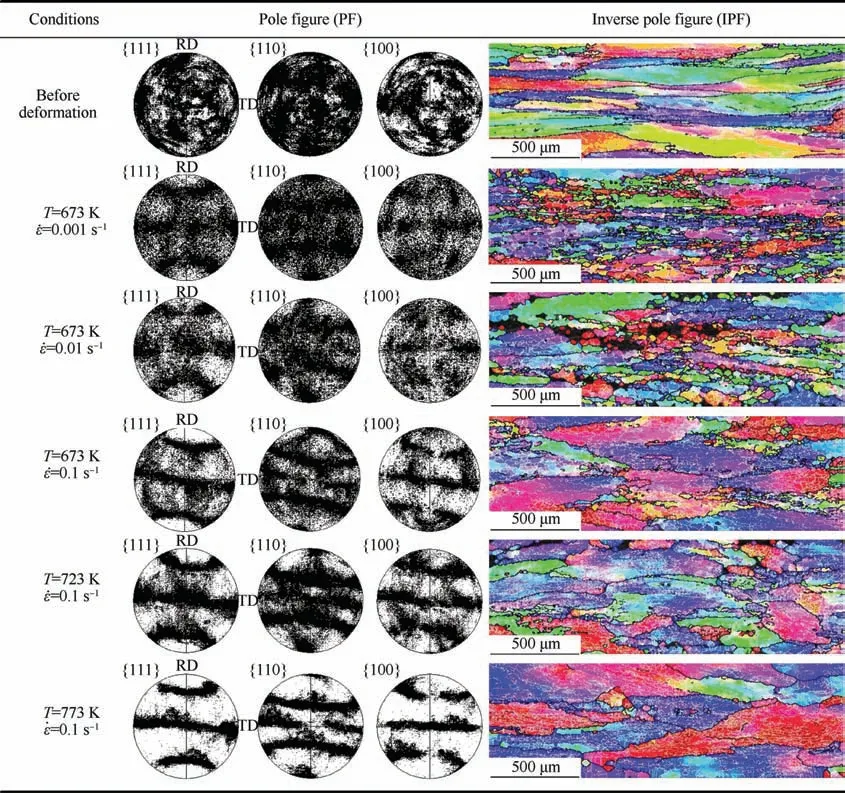
Fig. 5 Pole and inverse pole figures of 2297 Al-Li alloy.

Fig. 6 Inverse pole figures of samples with different shapes deformed at 673 K and 0.01 s-1.
Constitutive characteristic is a crucial issue to investigate the plastic deformation behavior of metallic material. Several constitutive formulas have been applied to predict the thermal flow behavior of aluminum alloys in previous literature.27In this research, the modified J-C formula and straincompensated Arrhenius-type model were utilized to characterize the flow behavior of 2297 Al-Li alloy.
3.3.1. The modified J-C model
The modified J-C model13is expressed as follow,

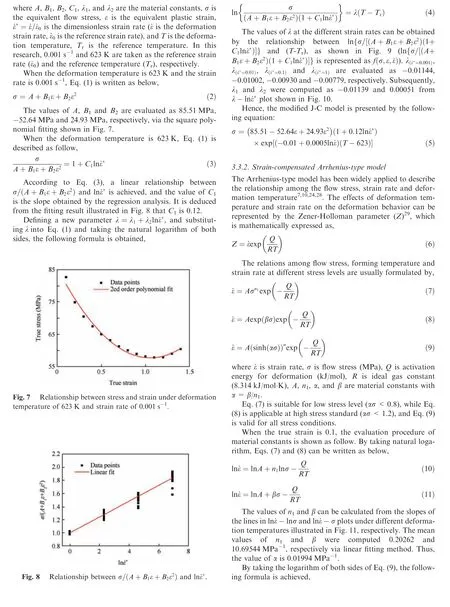


Fig. 11 Relation between strain rate and flow stress.
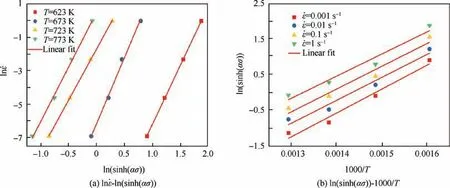
Fig. 12 The linear relationship of lnε˙ versus ln (s inh(α σ)) and ln(s inh(α σ)) versus 1000/T.
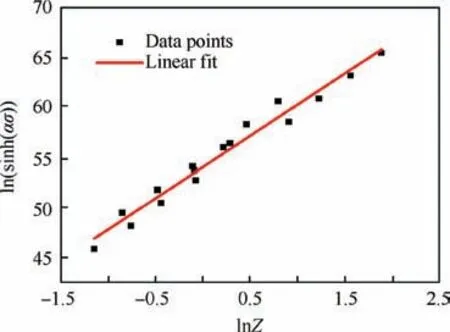
Fig. 13 Relationship between ln (s inh(α σ)) and lnZ.
3.3.3. Verification of the models
According to Eqs. (5) and (16), the flow stress was calculated with strain rates among 0.001-1 s-1and forming temperatures of 623-773 K. Fig. 13 illustrates the comparison between the experimental results and predicted ones via the established constitutive models,respectively.Compared with the modified J-C model, the strain-compensated Arrhenius-type equation presents more precise prediction for 2297 alloy, especially for the low strain. The predicted result of the modified J-C modeldeviates the experimental curves at the early yield stage,which means that the modified J-C model is not suitable to model the deformation behavior when the dynamic softening is not remarkable. To have a better illustration, the predictability of the two models is quantified by the correlation coefficient(Rc) and the average absolute relative error (AARE).

Table 1 Value of material constants at selected strains.

Table 2 Parameters of Arrhenius model with quintic polynomial fits.

Fig. 14 Comparison between experimental result and prediction at different strain rates.
The correlation coefficient, Rc, is expressed as follow,

The values of Rcfor the modified J-C equation and the strain-compensated Arrhenius model are 0.98635 and 0.98728, respectively.
The average absolute relative error, AARE, is formulated as below,

The values of AARE for the modified J-C and the Arrhenius models are 9.28 % and 9.20 %, respectively, which demonstrates the validity of the two kinds of constitutive models for the characterization of flow behavior under uniaxial compressive stress state (Fig. 14).

Fig. 15 Load-displacement curves obtained via experiment and FE simulation for different sample shapes.
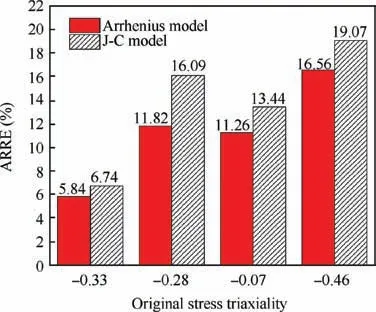
Fig.16 ARRE in FE simulations of the specimens with different stress triaxialities.
To verify the validity of the modified J-C model and straincompensated Arrhenius model under diverse stress states, the load-displacement curves for the thermal compression of the samples with different configurations obtained by experiment and FE simulation were compared, as depicted in Fig. 15. It is found that the modified J-C and strain-compensated Arrhenius models present pretty good predictive ability for the cylindrical specimens. Nevertheless, as the change of stress triaxiality in the deformation process, the deviation between experimental load-displacement curves and simulative ones is enlarged with the increase of plastic strain. The AARE in the FE simulations of different specimens is represented in Fig.16.It is suggested that the accuracy of constitutive models calibrated via uniaxial compression stress state is shifted down with increasing stress triaxiality, which means that the constitutive model is as sensitive as the other constitutive model. In the deformation of the cylindrical specimens, the compression deformation is homogeneous, and the profile of the specimen remains comparatively uniform. However, for the samples with tapered or flanged shapes,the stress state consists of hoop tensile stress and axial compressive stress.30Consequently, the validity of the two kinds of study constitutive model is limited by the stress state.
4. Conclusions
In this research,the microstructural evolution and constitutive behavior of 2297 Al-Li alloy were investigated by the hot compression tests at various temperatures ranging from 673 to 723 K and strain rates from 0.001 to 1 s-1.To verify the validity of the constitutive models under different stress triaxialities,the comparison of the load-displacement behavior of the samples with diverse configurations between experiment and FE simulation was conducted. The following conclusions were drawn according to the material flow behavior and microstructural characterization under hot compression:
(1) The work hardening and dynamic softening are competitive during the hot deformation process of 2297 Al-Li alloy, and the dynamic softening is more pronounced under low deformation temperature and high strain rate due to the deformation heating effect and microstructural instability.
(2) DRV becomes predominant at high deformation temperature to produce fine grain, and DRX phenomenon becomes dominant under the low strain rate and is sensitive to the stress state.
(3) Both the modified J-C and Arrhenius-type models are suitable for describing the hot deformation behavior of 2297 Al-Li alloy, while the latter reveals better prediction accuracy. The value of Rcand ARRE of Arrhenius-type model are 0.987% and 9.20%,respectively.
(4) The prediction accuracy of the modified J-C and Arrhenius-type models is worsened with the transformation of stress triaxiality in the deformation process, and the validity of the Arrhenius-type model is restricted by high stress triaxiality.
Acknowledgments
The authors would like to acknowledge the funding support to this research from the National Natural Science Foundation of China (Nos.: 51504227, 51635005 and 51605018) and Beijing Natural Science Foundation of China (No. 3172022).
杂志排行
CHINESE JOURNAL OF AERONAUTICS的其它文章
- Reliability and reliability sensitivity analysis of structure by combining adaptive linked importance sampling and Kriging reliability method
- Aeroelastic dynamic response of elastic aircraft with consideration of two-dimensional discrete gust excitation
- Thermal damage analysis of aircraft composite laminate suffered from lightning swept stroke and arc propagation
- An aerospace bracket designed by thermo-elastic topology optimization and manufactured by additive manufacturing
- Applications of structural efficiency assessment method on structural-mechanical characteristics integrated design in aero-engines
- An energy-based coupling degradation propagation model and its application to aviation actuationsystem
